navigation system INFINITI QX60 HYBRID 2016 Workshop Manual
[x] Cancel search | Manufacturer: INFINITI, Model Year: 2016, Model line: QX60 HYBRID, Model: INFINITI QX60 HYBRID 2016Pages: 651, PDF Size: 13.31 MB
Page 368 of 651
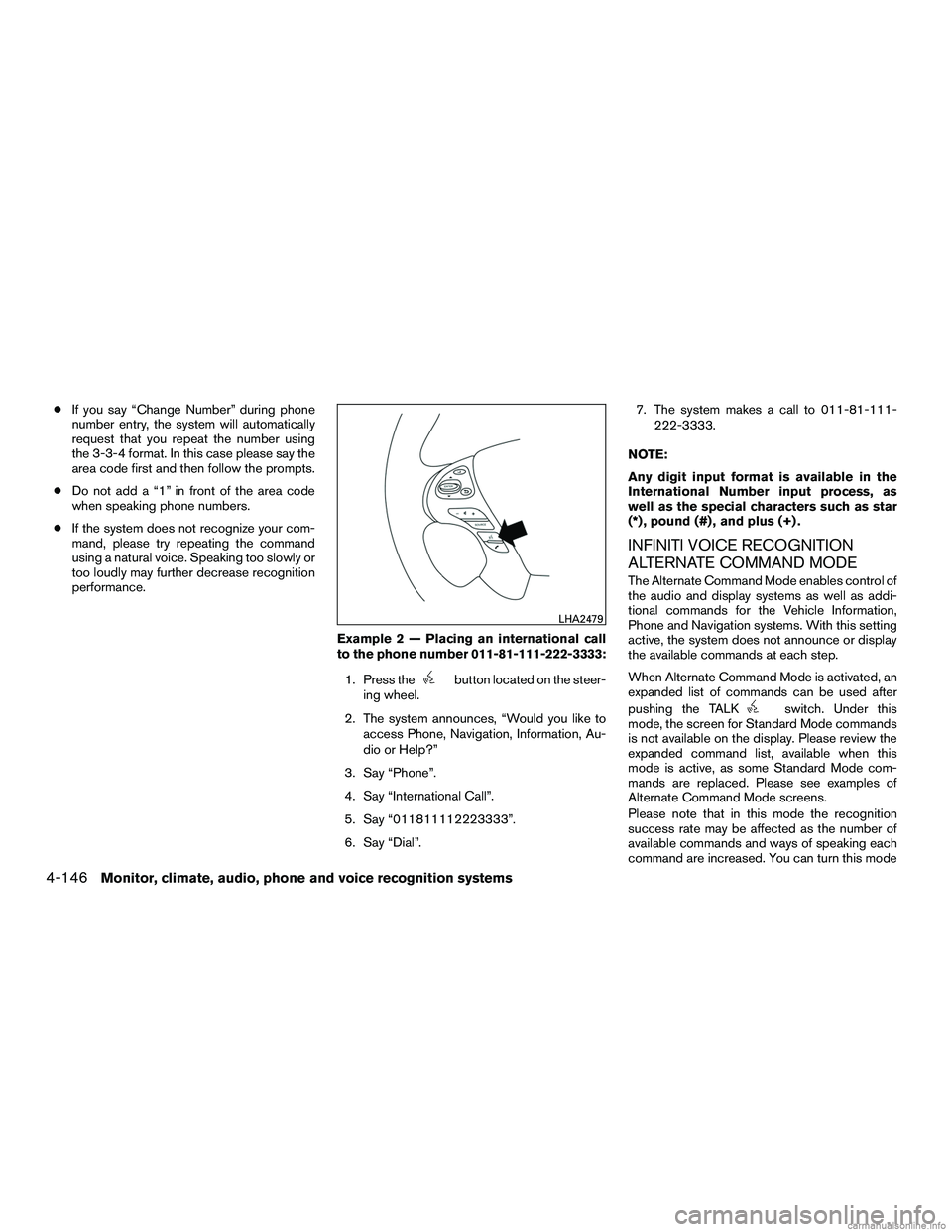
●If you say “Change Number” during phone
number entry, the system will automatically
request that you repeat the number using
the 3-3-4 format. In this case please say the
area code first and then follow the prompts.
● Do not add a “1” in front of the area code
when speaking phone numbers.
● If the system does not recognize your com-
mand, please try repeating the command
using a natural voice. Speaking too slowly or
too loudly may further decrease recognition
performance.
Example 2 — Placing an international call
to the phone number 011-81-111-222-3333:1. Press the
button located on the steer-
ing wheel.
2. The system announces, “Would you like to access Phone, Navigation, Information, Au-
dio or Help?”
3. Say “Phone”.
4. Say “International Call”.
5. Say “011811112223333”.
6. Say “Dial”. 7. The system makes a call to 011-81-111-
222-3333.
NOTE:
Any digit input format is available in the
International Number input process, as
well as the special characters such as star
(*) , pound (#) , and plus (+) .
INFINITI VOICE RECOGNITION
ALTERNATE COMMAND MODE
The Alternate Command Mode enables control of
the audio and display systems as well as addi-
tional commands for the Vehicle Information,
Phone and Navigation systems. With this setting
active, the system does not announce or display
the available commands at each step.
When Alternate Command Mode is activated, an
expanded list of commands can be used after
pushing the TALK
switch. Under this
mode, the screen for Standard Mode commands
is not available on the display. Please review the
expanded command list, available when this
mode is active, as some Standard Mode com-
mands are replaced. Please see examples of
Alternate Command Mode screens.
Please note that in this mode the recognition
success rate may be affected as the number of
available commands and ways of speaking each
command are increased. You can turn this mode
LHA2479
4-146Monitor, climate, audio, phone and voice recognition systems
Page 370 of 651
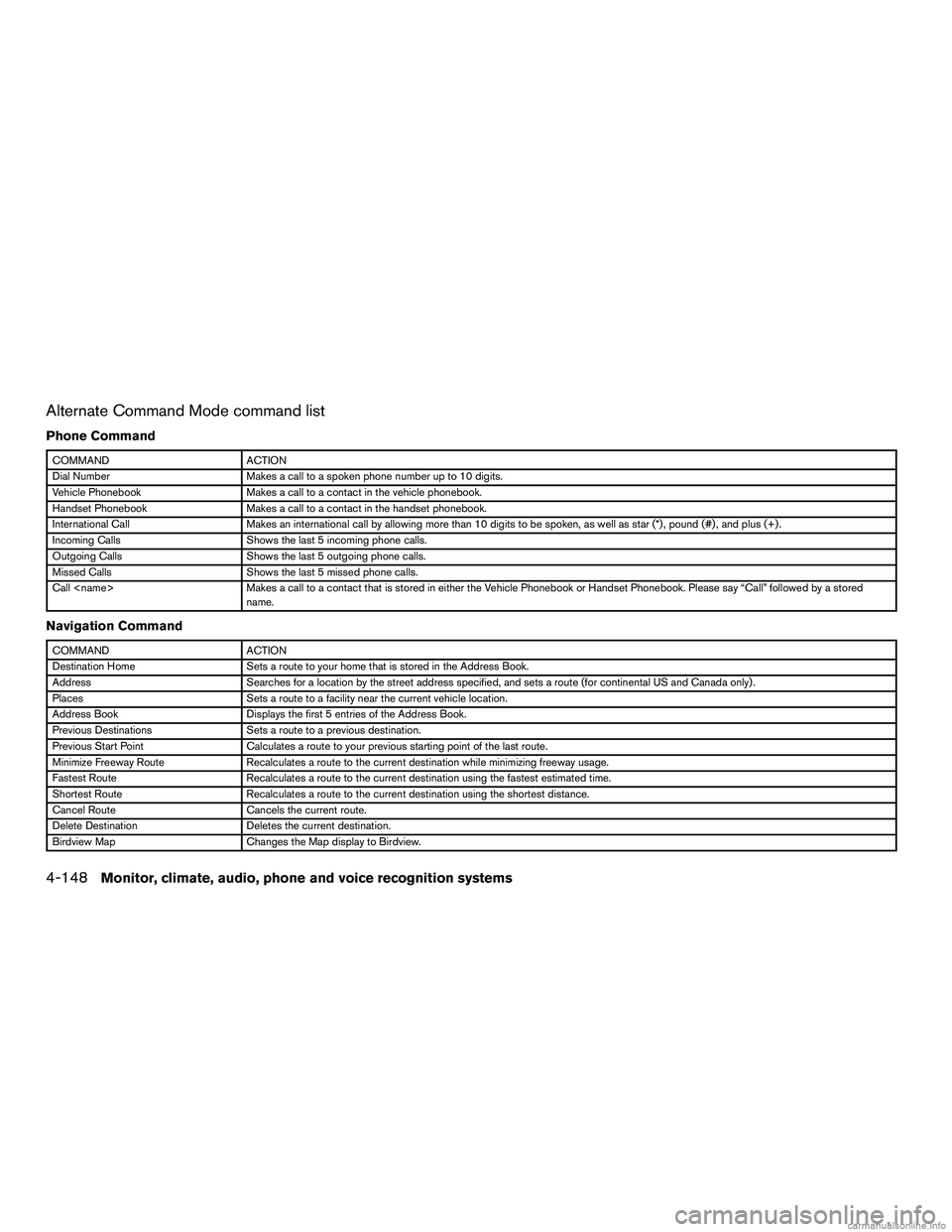
Alternate Command Mode command list
Phone Command
COMMANDACTION
Dial Number Makes a call to a spoken phone number up to 10 digits.
Vehicle Phonebook Makes a call to a contact in the vehicle phonebook.
Handset Phonebook Makes a call to a contact in the handset phonebook.
International Call Makes an international call by allowing more than 10 digits to be spoken, as well as star (*) , pound (#) , and plus (+) .
Incoming Calls Shows the last 5 incoming phone calls.
Outgoing Calls Shows the last 5 outgoing phone calls.
Missed Calls Shows the last 5 missed phone calls.
Call
name.
Navigation Command
COMMANDACTION
Destination Home Sets a route to your home that is stored in the Address Book.
Address Searches for a location by the street address specified, and sets a route (for continental US and Canada only) .
Places Sets a route to a facility near the current vehicle location.
Address Book Displays the first 5 entries of the Address Book.
Previous Destinations Sets a route to a previous destination.
Previous Start Point Calculates a route to your previous starting point of the last route.
Minimize Freeway Route Recalculates a route to the current destination while minimizing freeway usage.
Fastest Route Recalculates a route to the current destination using the fastest estimated time.
Shortest Route Recalculates a route to the current destination using the shortest distance.
Cancel Route Cancels the current route.
Delete Destination Deletes the current destination.
Birdview Map Changes the Map display to Birdview.
4-148Monitor, climate, audio, phone and voice recognition systems
Page 371 of 651
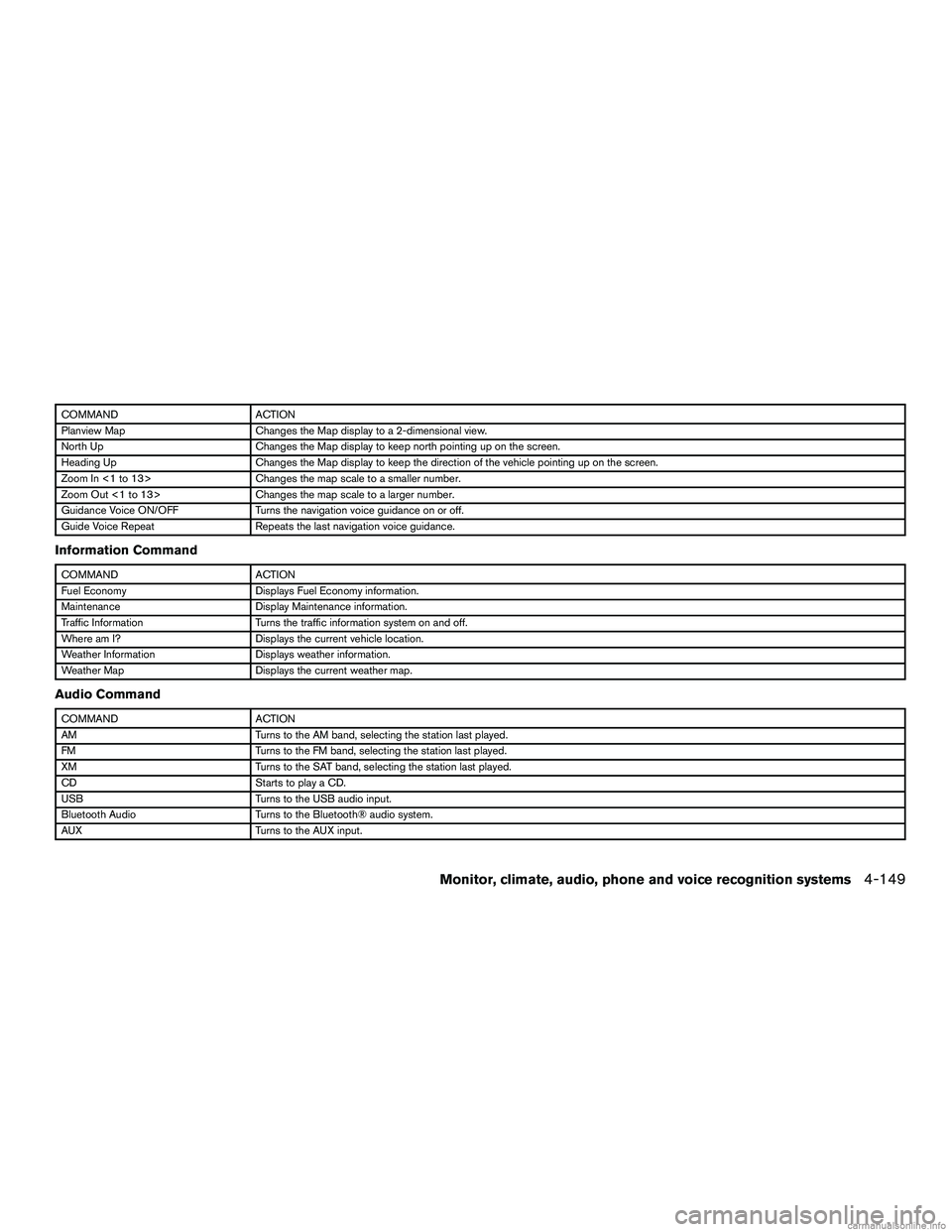
COMMANDACTION
Planview Map Changes the Map display to a 2-dimensional view.
North Up Changes the Map display to keep north pointing up on the screen.
Heading Up Changes the Map display to keep the direction of the vehicle pointing up on the screen.
Zoom In <1 to 13> Changes the map scale to a smaller number.
Zoom Out <1 to 13> Changes the map scale to a larger number.
Guidance Voice ON/OFF Turns the navigation voice guidance on or off.
Guide Voice Repeat Repeats the last navigation voice guidance.
Information Command
COMMANDACTION
Fuel Economy Displays Fuel Economy information.
Maintenance Display Maintenance information.
Traffic Information Turns the traffic information system on and off.
Where am I? Displays the current vehicle location.
Weather Information Displays weather information.
Weather Map Displays the current weather map.
Audio Command
COMMANDACTION
AM Turns to the AM band, selecting the station last played.
FM Turns to the FM band, selecting the station last played.
XM Turns to the SAT band, selecting the station last played.
CD Starts to play a CD.
USB Turns to the USB audio input.
Bluetooth Audio Turns to the Bluetooth® audio system.
AUX Turns to the AUX input.
Monitor, climate, audio, phone and voice recognition systems4-149
Page 375 of 651
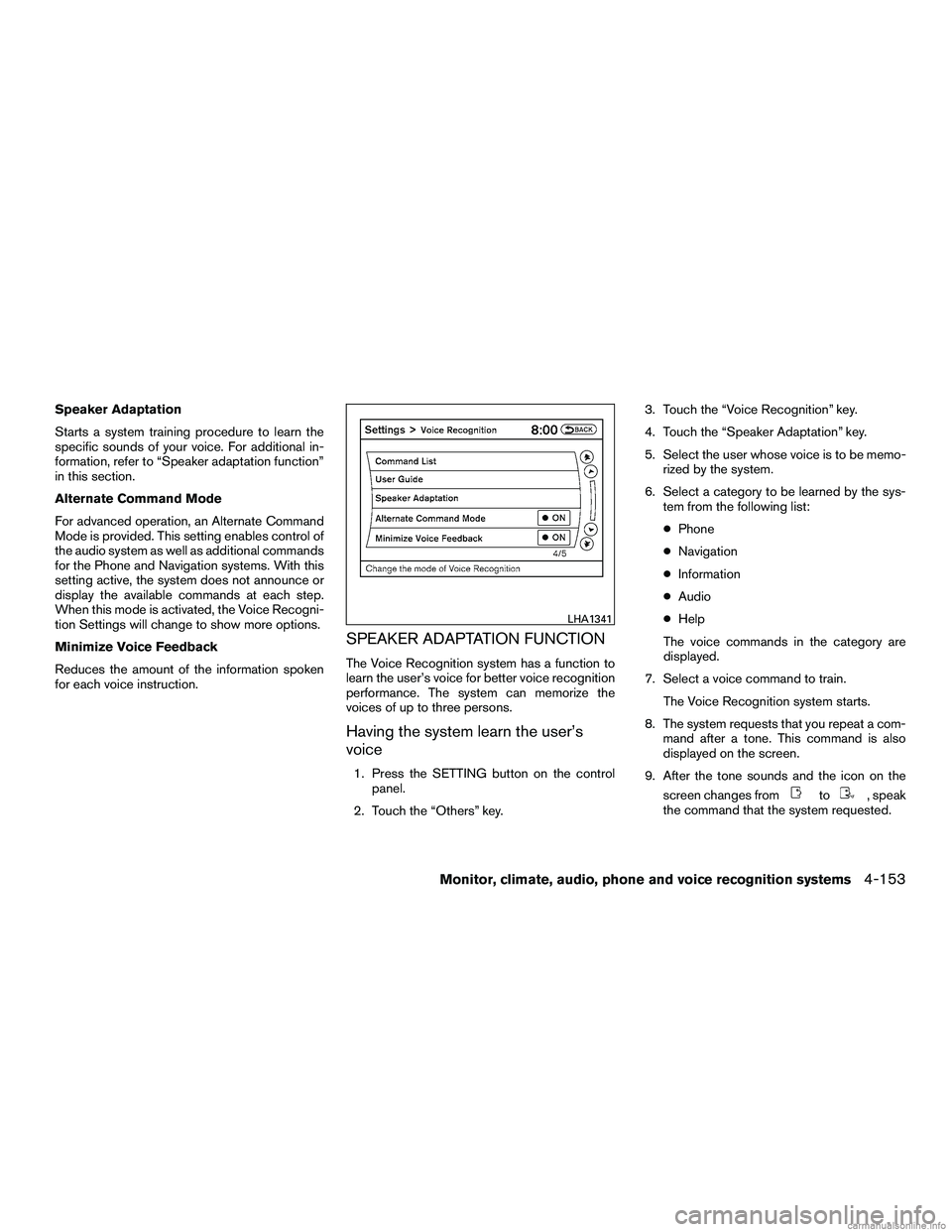
Speaker Adaptation
Starts a system training procedure to learn the
specific sounds of your voice. For additional in-
formation, refer to “Speaker adaptation function”
in this section.
Alternate Command Mode
For advanced operation, an Alternate Command
Mode is provided. This setting enables control of
the audio system as well as additional commands
for the Phone and Navigation systems. With this
setting active, the system does not announce or
display the available commands at each step.
When this mode is activated, the Voice Recogni-
tion Settings will change to show more options.
Minimize Voice Feedback
Reduces the amount of the information spoken
for each voice instruction.
SPEAKER ADAPTATION FUNCTION
The Voice Recognition system has a function to
learn the user’s voice for better voice recognition
performance. The system can memorize the
voices of up to three persons.
Having the system learn the user’s
voice
1. Press the SETTING button on the controlpanel.
2. Touch the “Others” key. 3. Touch the “Voice Recognition” key.
4. Touch the “Speaker Adaptation” key.
5. Select the user whose voice is to be memo-
rized by the system.
6. Select a category to be learned by the sys- tem from the following list:
● Phone
● Navigation
● Information
● Audio
● Help
The voice commands in the category are
displayed.
7. Select a voice command to train. The Voice Recognition system starts.
8. The system requests that you repeat a com- mand after a tone. This command is also
displayed on the screen.
9. After the tone sounds and the icon on the screen changes from
to, speak
the command that the system requested.
LHA1341
Monitor, climate, audio, phone and voice recognition systems4-153
Page 377 of 651
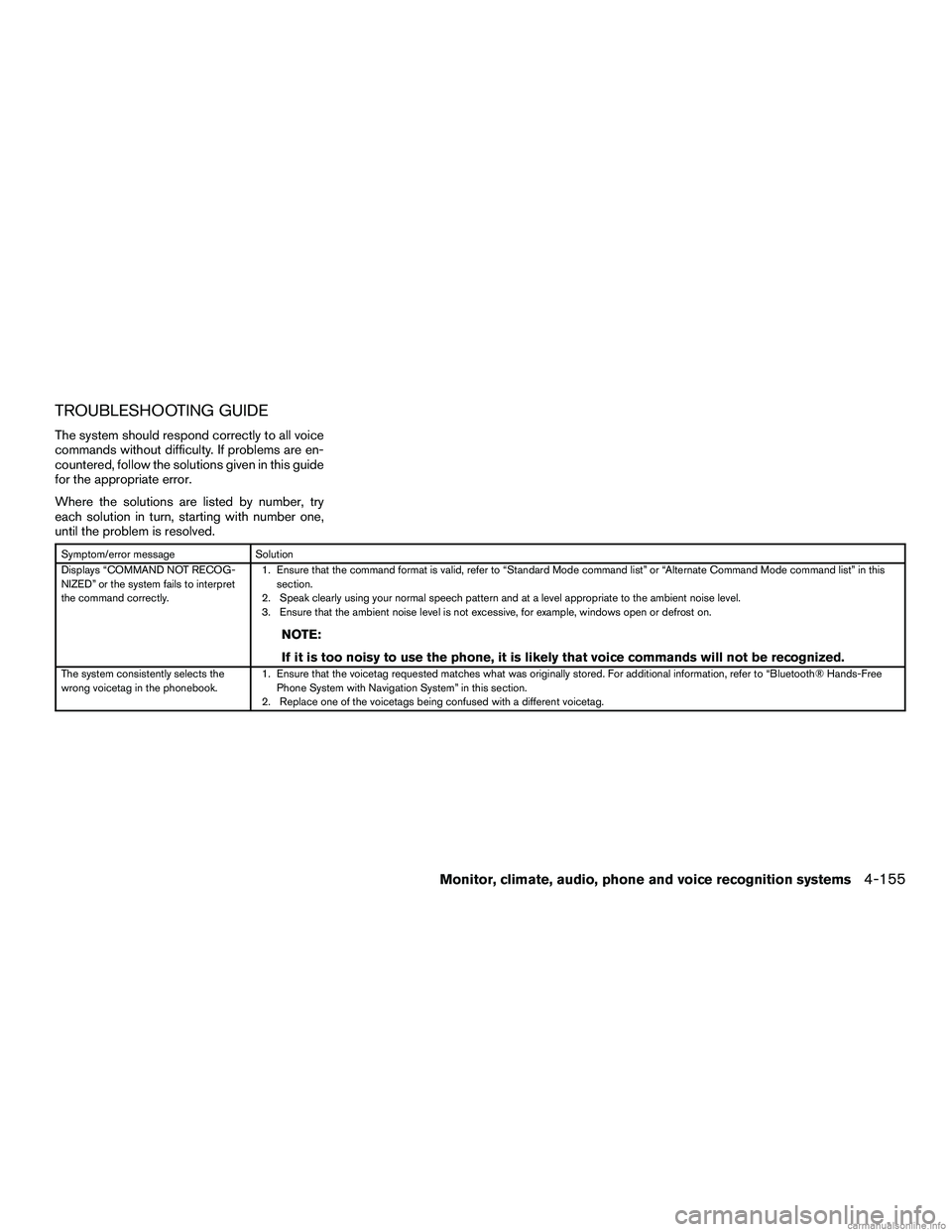
TROUBLESHOOTING GUIDE
The system should respond correctly to all voice
commands without difficulty. If problems are en-
countered, follow the solutions given in this guide
for the appropriate error.
Where the solutions are listed by number, try
each solution in turn, starting with number one,
until the problem is resolved.
Symptom/error messageSolution
Displays “COMMAND NOT RECOG-
NIZED” or the system fails to interpret
the command correctly. 1. Ensure that the command format is valid, refer to “Standard Mode command list” or “Alternate Command Mode command list” in this
section.
2. Speak clearly using your normal speech pattern and at a level appropriate to the ambient noise level.
3. Ensure that the ambient noise level is not excessive, for example, windows open or defrost on.
NOTE:
If it is too noisy to use the phone, it is likely that voice commands will not be recognized.
The system consistently selects the
wrong voicetag in the phonebook. 1. Ensure that the voicetag requested matches what was originally stored. For additional information, refer to “Bluetooth® Hands-Free
Phone System with Navigation System” in this section.
2. Replace one of the voicetags being confused with a different voicetag.
Monitor, climate, audio, phone and voice recognition systems4-155
Page 508 of 651
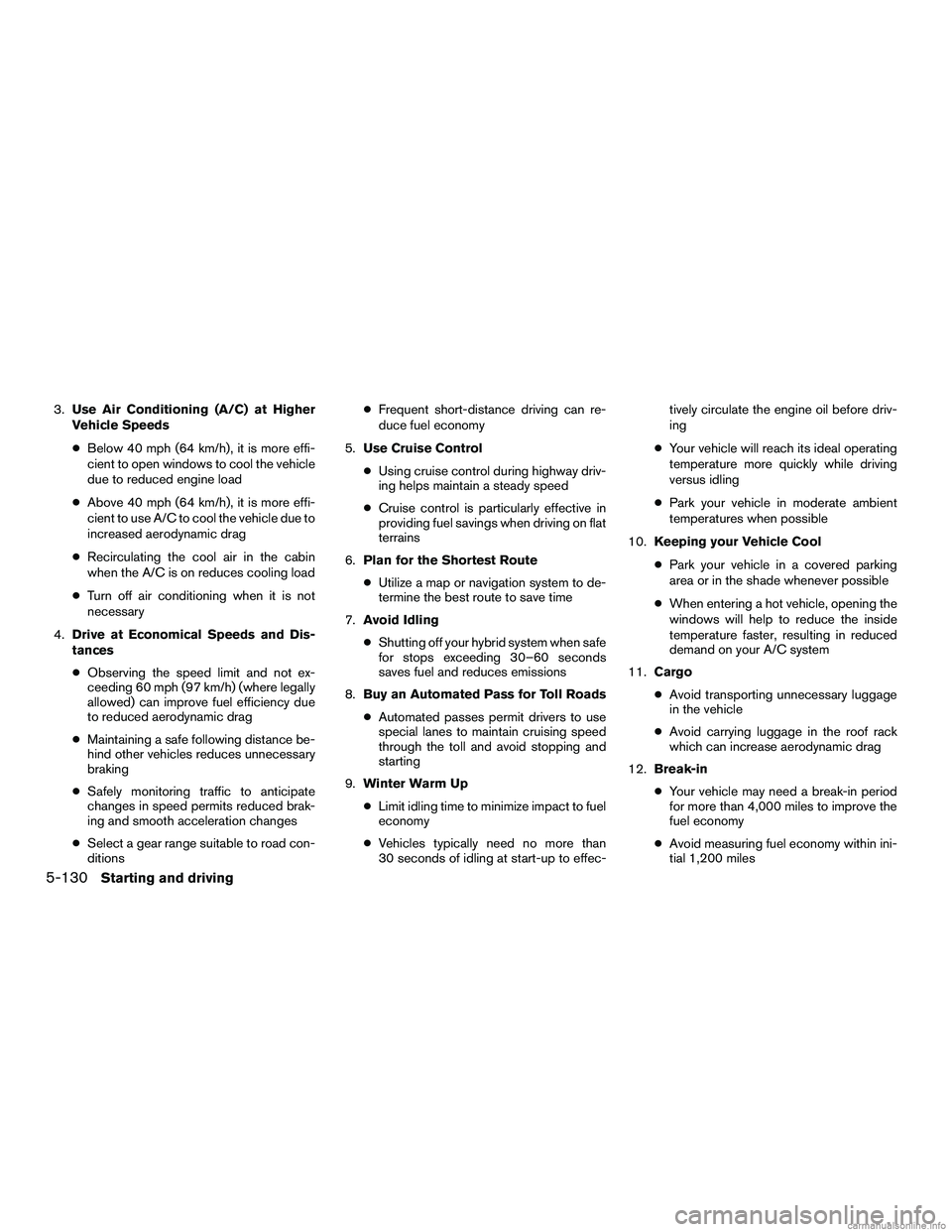
3.Use Air Conditioning (A/C) at Higher
Vehicle Speeds
● Below 40 mph (64 km/h), it is more effi-
cient to open windows to cool the vehicle
due to reduced engine load
● Above 40 mph (64 km/h), it is more effi-
cient to use A/C to cool the vehicle due to
increased aerodynamic drag
● Recirculating the cool air in the cabin
when the A/C is on reduces cooling load
● Turn off air conditioning when it is not
necessary
4. Drive at Economical Speeds and Dis-
tances
● Observing the speed limit and not ex-
ceeding 60 mph (97 km/h) (where legally
allowed) can improve fuel efficiency due
to reduced aerodynamic drag
● Maintaining a safe following distance be-
hind other vehicles reduces unnecessary
braking
● Safely monitoring traffic to anticipate
changes in speed permits reduced brak-
ing and smooth acceleration changes
● Select a gear range suitable to road con-
ditions ●
Frequent short-distance driving can re-
duce fuel economy
5. Use Cruise Control
● Using cruise control during highway driv-
ing helps maintain a steady speed
● Cruise control is particularly effective in
providing fuel savings when driving on flat
terrains
6. Plan for the Shortest Route
● Utilize a map or navigation system to de-
termine the best route to save time
7. Avoid Idling
● Shutting off your hybrid system when safe
for stops exceeding 30–60 seconds
saves fuel and reduces emissions
8. Buy an Automated Pass for Toll Roads
● Automated passes permit drivers to use
special lanes to maintain cruising speed
through the toll and avoid stopping and
starting
9. Winter Warm Up
● Limit idling time to minimize impact to fuel
economy
● Vehicles typically need no more than
30 seconds of idling at start-up to effec- tively circulate the engine oil before driv-
ing
● Your vehicle will reach its ideal operating
temperature more quickly while driving
versus idling
● Park your vehicle in moderate ambient
temperatures when possible
10. Keeping your Vehicle Cool
● Park your vehicle in a covered parking
area or in the shade whenever possible
● When entering a hot vehicle, opening the
windows will help to reduce the inside
temperature faster, resulting in reduced
demand on your A/C system
11. Cargo
● Avoid transporting unnecessary luggage
in the vehicle
● Avoid carrying luggage in the roof rack
which can increase aerodynamic drag
12. Break-in
● Your vehicle may need a break-in period
for more than 4,000 miles to improve the
fuel economy
● Avoid measuring fuel economy within ini-
tial 1,200 miles
5-130Starting and driving
Page 602 of 651

When planning to drive your INFINITI ve-
hicle in another country,you should first find
out if the fuel available is suitable for your vehi-
cle’s engine.
Using fuel with an octane rating that is too low
may cause engine damage. All gasoline vehicles
must be operated with unleaded gasoline. There-
fore, avoid taking your vehicle to areas where
appropriate fuel is not available.
When transferring the registration of your
vehicle to another country, state, province
or district, it may be necessary to modify the
vehicle to meet local laws and regulations.
The laws and regulations for motor vehicle emis-
sion control and safety standards vary according
to the country, state, province or district; there-
fore, vehicle specifications may differ.
When any vehicle is to be taken into an-
other country, state, province or district and
registered, its modifications, transporta-
tion, and registration are the responsibility
of the user. INFINITI is not responsible for
any inconvenience that may result.
VEHICLE IDENTIFICATION NUMBER
(VIN) PLATE
The VIN plate is located as shown. This number is
the identification for your vehicle and is used in
the vehicle registration.
The VIN number is also available through the
center display screen. For additional information,
refer to your “Navigation System Owner’s
Manual”.
VEHICLE IDENTIFICATION NUMBER
(chassis number)
The vehicle identification number is located as
shown.
TI1050MLTI2028
WHEN TRAVELING OR REGISTERING
IN ANOTHER COUNTRY VEHICLE IDENTIFICATION
9-10Technical and consumer information
Page 628 of 651
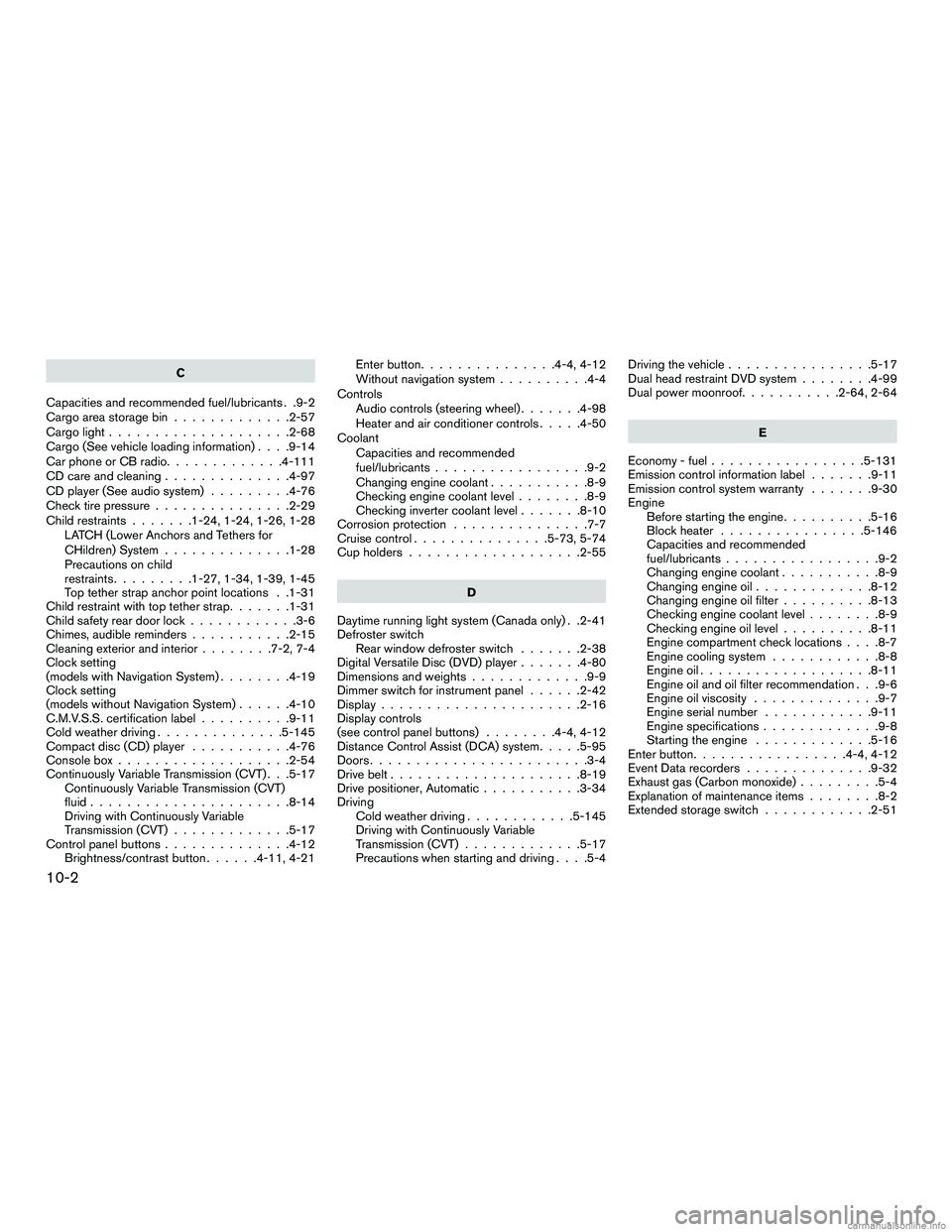
C
Capacities and recommended fuel/lubricants . .9-2
Cargo area storage bin .............2-57
Cargo light ....................2-68
Cargo (See vehicle loading information) . . . .9-14
Car phone or CB radio .............4-111
CD care and cleaning ..............4-97
CD player (See audio system) .........4-76
Check tire pressure ...............2-29
Child restraints .......1-24, 1-24, 1-26, 1-28
LATCH (Lower Anchors and Tethers for
CHildren) System ..............1-28
Precautions on child
restraints .........1-27, 1-34, 1-39, 1-45
Top tether strap anchor point locations . .1-31
Child restraint with top tether strap .......1-31
Child safety rear door lock ............3-6
Chimes, audible reminders ...........2-15
Cleaning exterior and interior ........7-2, 7-4
Clock setting
(models with Navigation System) ........4-19
Clock setting
(models without Navigation System) ......4-10
C.M.V.S.S. certification label ..........9-11
Cold weather driving ..............5-145
Compact disc (CD) player ...........4-76
Console box ...................2-54
Continuously Variable Transmission (CVT) . . .5-17 Continuously Variable Transmission (CVT)
fluid ......................8-14
Driving with Continuously Variable
Transmission (CVT) .............5-17
Control panel buttons ..............4-12
Brightness/contrast button ......4-11, 4-21 Enter button
...............4-4, 4-12
Without navigation system ..........4-4
Controls Audio controls (steering wheel) .......4-98
Heater and air conditioner controls .....4-50
Coolant Capacities and recommended
fuel/lubricants .................9-2
Changing engine coolant ...........8-9
Checking engine coolant level ........8-9
Checking inverter coolant level .......8-10
Corrosion protection .............. .7-7
Cruise
control ...............5-73, 5-74
Cup holders ...................2-55
D
Daytime running light system (Canada only) . .2-41
Defroster switch Rear window defroster switch .......2-38
Digital Versatile Disc (DVD) player .......4-80
Dimensions and weights .............9-9
Dimmer switch for instrument panel ......2-42
Display ......................2-16
Display controls
(see control panel buttons) ........4-4, 4-12
Distance Control Assist (DCA) system .....5-95
Doors ........................3-4
Drive belt .....................8-19
Drive positioner, Automatic ...........3-34
Driving Cold weather driving ............5-145
Driving with Continuously Variable
Transmission (CVT) .............5-17
Precautions when starting and driving . . . .5-4 Driving the vehicle
................5-17
Dual head restraint DVD system ........4-99
Dual power moonroof ...........2-64, 2-64
E
Economy - fuel .................5-131
Emission control information label .......9-11
Emission control system warranty .......9-30
Engine Before starting the engine ..........5-16
Block heater ................5-146
Capacities and recommended
fuel/lubricants .................9-2
Changing engine coolant ...........8-9
Changing engine oil .............8-12
Changing engine oil filter ..........8-13
Checking engine coolant level ........8-9
Checking engine oil level ..........8-11
Engine compartment check locations . . . .8-7
Engine cooling system ............8-8
Engine oil ...................8-11
Engine oil and
oil filter recommendation . . .9-6
Engine oil viscosity ..............9-7
Engine serial number ............9-11
Engine specifications .............9-8
Starting the engine .............5-16
Enter button .................4-4, 4-12
Event Data recorders ..............9-32
Exhaust gas (Carbon monoxide) .........5-4
Explanation of maintenance items ........8-2
Extended storage switch ............2-51
10-2
Page 633 of 651
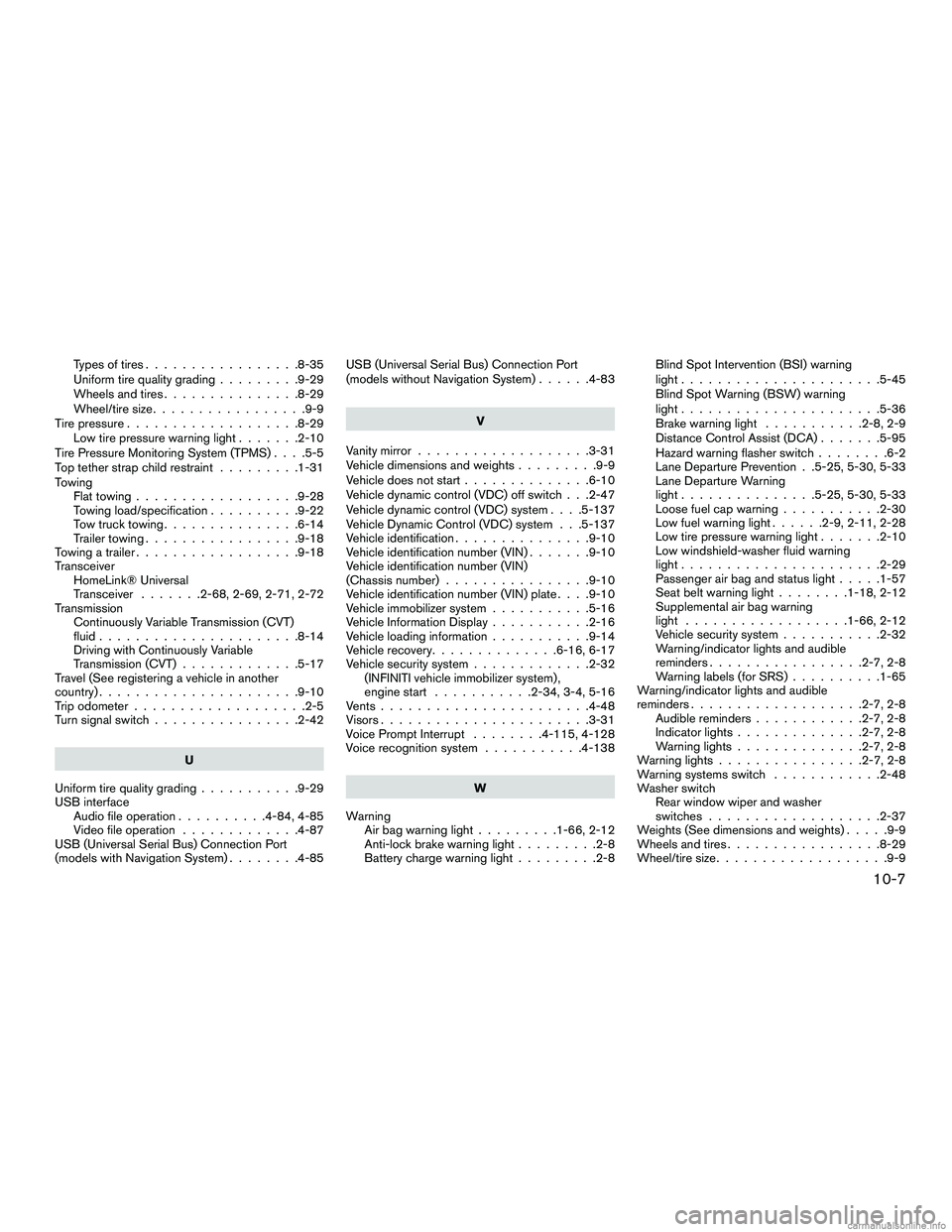
Types of tires.................8-35
Uniform tire quality grading .........9-29
Wheels and tires ...............8-29
Wheel/tire size .................9-9
Tire pressure ...................8-29
Low tire pressure warning light .......2-10
Tire Pressure Monitoring System (TPMS) . . . .5-5
Top tether strap child restraint .........1-31
Towing Flat towing ..................9-28
Towing load/specification ..........9-22
Tow truck towing ...............6-14
Trailer towing .................9-18
Towing a trailer ..................9-18
Transceiver HomeLink® Universal
Transceiver .......2-68, 2-69, 2-71, 2-72
Transmission Continuously Variable Transmission (CVT)
fluid ......................8-14
Driving with Continuously Variable
Transmission (CVT) .............5-17
Travel (See registering a vehicle in another
country) ......................9-10
Trip odometer ...................2-5
Turn signal switch ................2-42
U
Uniform tire quality grading ...........9-29
USB interface Audio file operation ..........4-84, 4-85
Video file operation .............4-87
USB (Universal Serial Bus) Connection Port
(models with Navigation System) ........4-85USB (Universal Serial Bus) Connection Port
(models without Navigation System)
......4-83
V
Vanity mirror ...................3-31
Vehicle dimensions and weights .........9-9
Vehicle does not start ..............6-10
Vehicle dynamic control (VDC) off switch . . .2-47
Vehicle dynamic control (VDC) system . . . .5-137
Vehicle Dynamic Control (VDC) system . . .5-137
Vehicle identification ...............9-10
Vehicle identification number (VIN) .......9-10
Vehicle identification number (VIN)
(Chassis number) ................9-10
Vehicle identification number (VIN) plate . . . .9-10
Vehicle immobilizer system ...........5-16
V ehicle Information
Display...........2-16
Vehicle loading information ...........9-14
Vehicle recovery ..............6-16, 6-17
Vehicle security system .............2-32
(INFINITI vehicle immobilizer system) ,
engine start ...........2-34, 3-4, 5-16
Vents .......................4-48
Visors .......................3-31
Voice Prompt Interrupt ........4-115, 4-128
Voice recognition system ...........4-138
W
Warning Air bag warning light .........1-66, 2-12
Anti-lock brake warning light .........2-8
Battery charge warning light .........2-8Blind Spot Intervention (BSI) warning
light
......................5-45
Blind Spot Warning (BSW) warning
light ......................5-36
Brake warning light ...........2-8, 2-9
Distance Control Assist (DCA) .......5-95
Hazard warning flasher switch ........6-2
Lane Departure Prevention . .5-25, 5-30, 5-33
Lane Departure Warning
light ...............5-25, 5-30, 5-33
Loose fuel cap warning ...........2-30
Low fuel warning light ......2-9, 2-11, 2-28
Low tire pressure warning light .......2-10
Low windshield-washer fluid warning
light ......................2-29
Passenger air bag and status light .....1-57
Seat belt warning light ........1-18, 2-12
Supplemental air bag warning
light ..................1-66, 2-12
Vehicle security system ...........2-32
Warning/indicator lights and audible
reminders .................2-7, 2-8
Warning labels (for SRS) ..........1-65
Warning/indicator lights and audible
reminders ...................2-7, 2-8
Audible reminders ............2-7, 2-8
Indicator lights ..............2-7, 2-8
Warning lights ..............2-7, 2-8
W arning lights...............
.2-7, 2-8
Warning systems switch ............2-48
Washer switch Rear window wiper and washer
switches ...................2-37
Weights (See dimensions and weights) .....9-9
Wheels and tires .................8-29
Wheel/tire size ...................9-9
10-7